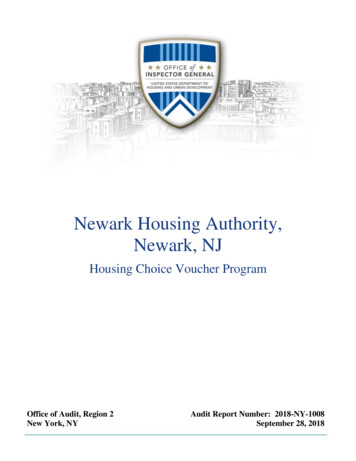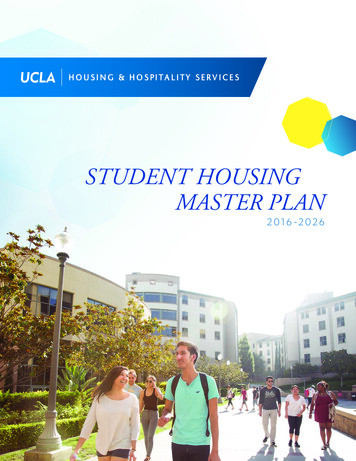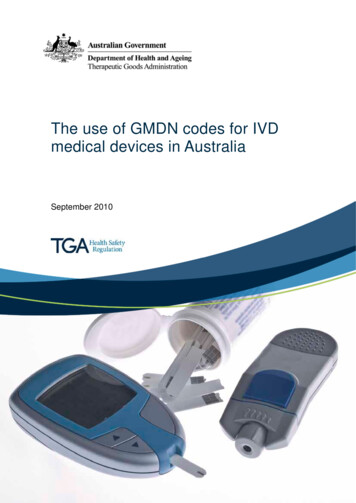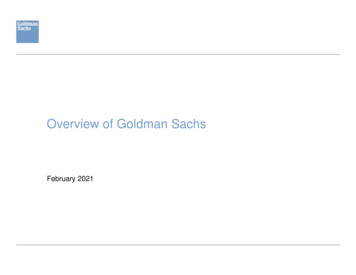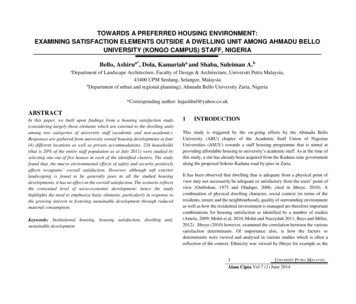
Transcription
TOWARDS A PREFERRED HOUSING ENVIRONMENT:EXAMINING SATISFACTION ELEMENTS OUTSIDE A DWELLING UNIT AMONG AHMADU BELLOUNIVERSITY (KONGO CAMPUS) STAFF, NIGERIABello, Ashirua*, Dola, Kamariaha and Shaba, Suleiman A.baDepartment of Landscape Architecture, Faculty of Design & Architecture, Universiti Putra Malaysia,43400 UPM Serdang, Selangor, MalaysiabDepartment of urban and regional planning), Ahmadu Bello University Zaria, Nigeria*Corresponding author: hajashbel@yahoo.co.ukABSTRACTIn this paper, we built upon findings from a housing satisfaction study(considering largely those elements which are external to the dwelling unit)among two categories of university staff (academic and non-academic).Responses are gathered from university owned housing developments at four(4) different locations as well as private accommodations. 224 households(that is 20% of the entire staff population as at July 2011) were studied byselecting one out of five houses in each of the identified clusters. The studyfound that, the macro environmental effects of safety and security positivelyaffects occupants’ overall satisfaction. However, although soft exteriorlandscaping is found to be generally poor in all the studied housingdevelopments, it has no effect on the overall satisfaction. The scenario reflectsthe contextual level of socio-economic development; hence the studyhighlights the need to emphasize basic elements, particularly in response tothe growing interest in fostering sustainable development through reducedmaterial consumption.Keywords: Institutional housing, housing satisfaction, dwelling unit,sustainable development1INTRODUCTIONThis study is triggered by the on-going efforts by the Ahmadu BelloUniversity (ABU) chapter of the Academic Staff Union of NigerianUniversities (ASUU) towards a staff housing programme that is aimed atproviding affordable housing to university’s academic staff. As at the time ofthis study, a site has already been acquired from the Kaduna state governmentalong the proposed Sokoto-Kaduna road by-pass in Zaria.It has been observed that dwelling that is adequate from a physical point ofview may not necessarily be adequate or satisfactory from the users’ point ofview (Onibokun, 1973 and Oladapo, 2006; cited in Jiboye, 2010). Acombination of physical dwelling character, social context (in terms of theresidents, tenure and the neighbourhood), quality of surrounding environmentas well as how the residential environment is managed are therefore importantcombinations for housing satisfaction as identified by a number of studies(Amole, 2009; Mohit et al, 2010; Mohit and Nazzydah 2011; Buys and Miller,2012). Jiboye (2010) however, examined the correlation between the varioussatisfaction determinants. Of importance also, is how the factors ordeterminants were viewed and analysed in various studies which is often areflection of the context. Ethnicity was viewed by Jiboye for example as the3UNIVERSITI PUTRA MALAYSIAAlam Cipta Vol 7 (1) June 2014
geopolitical zoning which may not necessarily be an indicator of strong ethnicsimilarity in other places.Figure 1: Location of the proposed site for ABU-ASUU housing projectThe need for information about the adequacy and success of housing designs,once they are built, has dominated the minds of not only professionals in thebuilt environment but also the policy makers. In fact, one of the taskconfronting policy-makers, planners and housing developers is to identifyrelevant factors or parameters which determine users’ satisfaction with theirhousing.4UNIVERSITI PUTRA MALAYSIAAlam Cipta Vol 7 (1) June 2014Individuals and families want to stay in places where they feel comfortable incarrying out their daily interactions. Where residential deficits exist, housingsatisfaction is affected which consequently triggers the tendency to adjusthousing. According to Alalade (1978), housing adjustment is achieved eitherin Residential mobility or Residential adaptation, which refers to tendency ofresidents to move from one residential area to another within a local area or a
situation where residents engage in alteration of their dwellings in an attemptto make it more liveable respectively.Alterations usually take the form of addition of rooms, conversion of use anddemarcation of spaces. An earlier study of housing condition within theAhmadu Bello University (main campus) staff housing revealed clearevidences of residential adaptation (Dawen et al. 2001). This study thereforesets out to determine the perspectives of housing satisfaction among staff inAhmadu Bello University (Kongo campus). This will subsequently guidehousing projects (private and public) particularly those targeted at middleclass and the low income. A good example can be the Ahmadu BelloUniversity Academic Staff Housing initiative currently in process.The study is concerned with factors which are external to dwellings butcombine with those of dwellings to provide satisfaction. The housing unitsstudied are the on-campus and the off-campus staff housing (includinguniversity accommodation and private accommodation). The residential areasstudied are the on-campus staff quarters, Banzazzau quarters, staff whitehouse and dwellings on 2, western way, GRA.2METHODOLOGY2.1The Kongo CampusAhmadu Bello University, Kongo Campus is situated at Tudun Wada. Kongocampus is bounded to the north by river Kubanni, to the west by Kamashastream and to the south by Banzazzau quarters and the New Jos road. KongoCampus is located on latitude 11 30'N and longitude 7 50'E on an elevationof about 686m above sea level.Fig 2: Location of the residential areas in ZariaAhmadu Bello University, Kongo campus is in Zaria urban area and thereforefalls within the Savannah climate, according to Koppen’s world climateclassification. It has a mean annual rainfall of about 1000mm (Ati et al, 2009).The mean maximum temperature occurs in April and minimum temperatureoccurs between December and January. Tudun Wada also has the naturalvegetation of the Northern Guinea Savannah.2.2Data assemblyA survey was carried out in July 2011, covering two broad categories ofresidential areas; the university accommodation (both on-campus and offcampus) and the non-university accommodation (off-campus). Questionnairewas administered to obtain the responses from residents in the variousresidential areas.Several visits were also made to some residences to pry out some informationinformally which otherwise could be impossible to obtain by the use of formal5UNIVERSITI PUTRA MALAYSIAAlam Cipta Vol 7 (1) June 2014
means such as questionnaire and to make physical observation of theseresidential areas.accessibility to other activity centres, as well as external facilities for refusedisposal and landscape elements.Consultations were held with some members of Estate Department to help incategorizing staff occupancy status and the different residential areas.At the time of this study, there were 1120 members of staff at the ABU(Kongo campus) Zaria, 274 occupying university housing (both on-campusand off-campus) and 846 staying on non-university housing. The survey wascarried out on 224 households. The approach involved administering aquestionnaire to one out of every five household with their individual housingunit in both the university and non-university residential areas. Altogether thenumber of questionnaire administered in all the residential areas, both oncampus and off-campus, constitute 20% of the total staff population.3Table 1: Breakdown of Questionnaire Administered3.1.1 On-Campus Staff QuartersResidential AreaOn-campus staffqtrsStaff white houseBanzazzau qtrs2western way,GRAPrivateAccommodationTOTALNumber 6112016922416021395Although several attributes related to housing satisfaction were examined, thefocus of this study was on those elements that are considered external to thedwelling unit. They include safety and security of the neighbourhood,6UNIVERSITI PUTRA MALAYSIAAlam Cipta Vol 7 (1) June 2014RESULTS AND DISCUSSION3.1Characteristics of Residential AreasAhmadu Bello University, Kongo Campus was founded in 1947 as a clericalcentre and was incorporated into Ahmadu Bello University on the 4th ofOctober, 1962. This was the oldest institution of higher learning in WestAfrica devoted to teaching of Administration, Finance and Law. Theinstitution houses the University's faculty of Law, faculty of Administrationtogether with department of Local Government Studies and Centre for Islamicstudies. Nature and Type of dwellingThe staff quarters comprised of 178 dwelling units. These dwelling units arecategorized into 4 types: The 4-bedroom type; 3-bedroom type; 2-bedroomtype and 1 bedroom type. The structures are mainly built with cement(hollow) block, but very few are found to have been built with both cementblocks and mud bricks. The 4 bedrooms and 3 bedrooms are occupied bysenior staff. The 4 bedroom types are 16 in number and are mainlyprofessorial units. While the 3 bedroom type are 70 in number and aredetached units. The 2 and 1 bedroom types are 70 and 22 in numbersrespectively. These units are meant for university staff in the lower cadre. Facilities and UtilitiesAll the dwelling units have been provided each with a toilet and kitchen,although some residents are found to cook outside. The units have adequateaccess to power and pipe borne water supply. The street pattern here followsthe grid iron concept with most streets tarred.
Plate 1: 2 Storey Apartment Comprising 6 Units and a DuplexPlate 2: Detached and semi-detached units7UNIVERSITI PUTRA MALAYSIAAlam Cipta Vol 7 (1) June 2014
3.1.2 Staff White House, Gyallesuvery bad state due to erosion, making streets narrow and steep. The drainagesare also in bad condition due mainly to lack of maintenance. Nature and type of dwellingThe staff white house is a two storey building rented off-campus by theuniversity. It covers a land area of 0.08 hectare (970m²). It is located north ofthe university. It comprises eight units including units that are built close tothe storey. Each of the apartments is a 2-bedroom type; the structure is builtwith cement block and reinforced concrete. Facilities and UtilitiesThe Apartments have been provided each with kitchen and a toilet. Theseunits are enclosed with a fence. This provides a secure parking space forresidents. The apartments have access to pipe borne water supply and powersupply. However, water supply here is not regular. The apartments areprovided with two large water storage tanks to supplement the pipe bornewater supply.The building is linked with an un-tarred access road which is fair in conditionbut the main road linking the access road is tarred but is in a poor withnumerous pot holes. The drainage channels along these roads are fair incondition.3.1.3 Ban-Zazzau Quarters Nature and Type of dwellingThe Banzazzau quartersare located south of the university. It covers an areaof 3.02 hectares (30, 151m2) and comprising 77 houses built with cementblock. Two types of units are found in the area the 2-bedroom and 1-bedroomtypes. 54 of the units are 2-bedrooms types and the 23 units are the 1-bedroomtype. The units are semi-detached houses. Facilities and UtilitiesThe houses are built with courtyards with a kitchen and toilets. The streetpattern follows the linear concept. The roads in this area are untarred and in8UNIVERSITI PUTRA MALAYSIAAlam Cipta Vol 7 (1) June 2014Plate 3: Staff White HouseThe houses have access to power and pipe borne water supply. However, thetaps remain dry and can stay in that state for a period of six weeks as disclosedby some residents. As such therefore, use of well as a source of domestic watersupply is resorted to.3.1.4 Western Way, G.R.A Nature and Type of dwellingEleven (11) of the houses on 2 Western Way GRA Zaria have been allocatedto staff of A.B.U Kongo campus. These comprises of individual dwellingsand also a compound setting.
Plate 4: Ban-zazzau QuartersThe compound consists of 5 detached units while the remaining 6 units areoutside the compound along the street. The dwellings are built with cementmainly. Seven of the dwellings are 3 bedroom types and four are 2 bedroomtypes. Facilities and UtilitiesThe dwellings all have access to power and pipe borne water supply. Eachdwelling consists of a kitchen and toilet including the units in the compound.Residents in the compound make use of water from well in the compoundsince pipe borne water supply is not consistent and readily available. Thestreet linking these units is untarred but fair in condition.Plate 5: The GRA Quarters9UNIVERSITI PUTRA MALAYSIAAlam Cipta Vol 7 (1) June 2014
3.1.5 The Private AccommodationThese private dwellings found off-campus are differently located andoccupied by staff of ABU (Kongo campus) Zaria, without the university’sintervention. The houses found in these areas can be broadly categorized into Single detached house Semi-detached house Compound Duplex3.2Household SizeThree categories of household sizes were recognised in the residential areas,large, medium and small household sizes. 22.5% of the total sampledhousehold in the university residential area are large, with more than 7persons, 46.5% are medium size households with 5-6 persons, while 31%constitute the small household size with 3-4 persons. In the non-universityresidential areas 55% of the total sampled household are large with more than7 persons, 35% are medium size households with 5-6 persons, while 10%constitute the small household size with 3-4 persons. Figure 3 below showsthe percentage distribution of household by sizes in the residential areas.100%80%60%(7 and above)40%(5-6)20%(1-4)0%On-campus Staff white Banzazzaustaff qrtrshouseqtrsFig 3: Distribution of Households by Sizes10UNIVERSITI PUTRA MALAYSIAAlam Cipta Vol 7 (1) June 20142westernway, GRAPrivateaccom
There is an inverse relationship between household size and overall level ofsatisfaction of residents (keeping other variables constant). The level ofsatisfaction decreases among larger households in all the areas. The reasonbeing that the larger the household size, the more inadequate the facilities andspace in housing are likely to be.3.3Indicative analysis using multiple regressionsSix variables were considered in the analysis that follows as elements thatwere examined being external to the dwelling unit. They are neighbourhoodsafety, neighbourhood social interaction, refuse collection system, childrenplay ground, accessibility to place of work and exterior (common) landscape.Table 2:Variables used for multiple regressions in indicative analysisVariableMeasurement levelCategoriesRatio (ordinal)1 Not satisfied atHousing satisfactionall(dependant variable)5 Very satisfied0 comfortable withNeighbourhood safety Nominallocating near a policepost1 Fear of locatingnear a police post0 no socialNeighbourhood social Nominalcontacts with otherinteractionresidents1 there is socialcontactsNominal0 poorRefuse collection1 goodNominal0 inaccessibleChildren play ground1 AccessibleNominal0 difficultAccess to work place1 easy0 generally poorExterior(common) Nominal1 generally goodlandscapeWe ignored the fact that formal conditions for a linear multiple regressionsare not completely met. For indicative analysis, such a problem is of minorimportance (Elsinga and Hoekstra, 2005).For the different residential locations, a separate multiple regression analysiswas conducted. Following a phased methodology, neighbourhood safety wasconsidered in the first phase while other variables such as neighbourhoodsocial interaction, access to work place and exterior landscape weresubsequently taken into account.In the first phase of the analysis, only the ‘neighbourhood safety’ variable wasintroduced. The beta coefficient is positive for all the five residential areas.This indicates a positive relationship between the dummy variable‘neighbourhood safety’ and the variable ‘overall housing satisfaction’(without controlling for other relevant variables).Subsequently, the variable ‘neighbourhood social interaction’ is introducedinto the model. The introduction of this variable results in a (substantial)reduction in the values of beta coefficients for the first variable‘neighbourhood safety’ though positive and statistically significant in all theresidential areas.In phase three, the variable ‘refuse collection’ was introduced. The betacoefficients remained positive and statistically significant for all the fiveresidential areas. However, the relationship seems to be higher in 2, WesternWay and the on-campus staff accommodation being seemingly moreorganized (physically) than other areas. The introduction of this variable doesnot bring about major changes in the coefficients for ‘neighbourhood safety’.In the fourth phase, the variable ‘children play ground’ was introduced. Therelationship with independent variable is significant and positive in all theresidential areas with the exception of Ban-Zazzau quarters and 2, WesternWay. Beta coefficients for other variables remained positive and statisticallysignificant.11UNIVERSITI PUTRA MALAYSIAAlam Cipta Vol 7 (1) June 2014
Table 3: Beta parameters and explained variance in the five residential areasPhaseNeighbourhood safety; Neighbourhood social interaction;1Refuse collection; Children play ground; Access to workplace; Exterior (common) landscape; R2Neighbourhood safety;2Neighbourhood social interactionRefuse collection; Children play groundAccess to work placeExterior (common) landscapeR2Neighbourhood safety3Neighbourhood social interactionRefuse collectionChildren play groundAccess to work placeExterior (common) landscapeR2Neighbourhood safety4Neighbourhood social interactionRefuse collectionChildren play groundAccess to work placeExterior (common) landscapeR2Neighbourhood safety5Neighbourhood social interactionRefuse collectionChildren play groundAccess to work placeExterior (common) landscapeR2Neighbourhood safety6Neighbourhood social interactionRefuse collectionChildren play groundAccess to work placeExterior (common) landscapeR2*Not significant statistically (P 0.05)12UNIVERSITI PUTRA MALAYSIAAlam Cipta Vol 7 (1) June 2014OC0.28SWH0.17BZ0.292, 1*0.110.02*0.280.210.110.100.050.00*0.070.02*0.22
With the introduction of the fifth variable ‘access to work place’ in phase 5,the situation remained somehow unchanged in all the residential areas on allthe preceding variables with the exception of ‘children play ground’ whichadditionally became statistically insignificant in private accommodation.In the final phase, although ‘exterior (common) landscape’ was observed tobe poor in all the residential areas, its relationship with ‘overall housingsatisfaction’ is statistically insignificant in all the residential areas except theon-campus staff accommodation. Also, introduction of the variable had noeffect on the beta coefficients of other variables in the model. Explaining only14% (in staff white house) and 25% (in private accommodation) of thevariance of the dependant variable, the model suggests that housingsatisfaction is not dependant on the variables included but that other aspects(internal elements and psychological factors) also play a part.4CONCLUSIONAlthough human needs and preferences are not static since they tend torespond to prevailing circumstances, some design elements for housingdevelopments continued to show significant relevance to satisfaction overtime. This study found that housing satisfaction is not dependant on thevariables included (neighbourhood safety, neighbourhood social interaction,refuse collection system, children play ground, accessibility to place of workand exterior (common) landscape) but that other aspects (internal elementsand psychological factors) also play a part. Issues relating to safety as well aspresence of certain communal facilities and design concepts that may enhancesocial interaction are essential considerations in housing design process. Sincemost of the elements considered as external to the dwelling unit can beintegrated into the design prior to occupation, overall satisfaction can bemedium cost terrace houses where the semi-public spaces available in theforefront of the house areas had been changed as their ‘Extended Garden’ oradditional area for landscaping. These finding shows that the size of greenarea (private and semi-public green area) in typical terrace houses layout inurban area are not appropriate and not achieve the occupant needs.improved by such integration of components that can be captured even at thelevel of sites and services.REFERENCESAlalade, E.A. (1978) User Satisfaction Study of Jaoji Housing Estate in Kano.Unpublished M.Sc Thesis, Department of U.R.P, A.B.U., Zaria.Amole, D. (2009) Residential satisfaction in student’s housing. Journal ofEnvironmental Psychology, 29 (1): 76–85Ati, O. F., Stigter,C.J., Iguisi, E.O. & Afolayan, J.O. (2009)Profile of Rainfall Changeand Variability in the Northern Nigeria, 1953-2002.Research Journal ofEnvironmental and Earth Sciences, 1(2): 58-63Buys, L.& Miller, E. (2012) Residential satisfaction in inner urban higher-densityBrisbane, Australia: Role of dwelling design, neighbourhood and neighbours.Journal of Environmental Planning and Management, 55(3): 319–338.Dawen, Y. et al (2001) “User satisfaction of staff housing in A.B.U. (main campus)Zaria” Unpublished B.URP Project, Department of Urban and regionalplanning, A.B.U., Zaria.Elsinga, M. and Hoekstra, J. (2005) Homeownership and housing satisfaction. Journalof Housing and the Built Environment, 20(4):401–424Jiboye, A. D. (2010) The correlates of public housing satisfaction in Lagos, Nigeria.Journal of Geography and Regional Planning, 3(2): 017-028Mohit, M. A. & Nazzydah, N. (2011)Social housing programme of Selangor ZakatBoard of Malaysia and housing satisfaction. Journal of Housing and the Builtenvironment, 26 (2): 143-164Mohit, M. A., Ibrahim, M.& Rashid Y. R. (2010)Assessment of residential satisfactionin newly designed public low-cost housing in Kuala Lumpur, Malaysia.Habitat International, 34 (1): 18–27Onibokun,A. G.(1973) Environmental Issues in Housing Habitability. EnvironmentalPlanning,5(4): 461-476.13UNIVERSITI PUTRA MALAYSIAAlam Cipta Vol 7 (1) June 2014
University Academic Staff Housing initiative currently in process. The study is concerned with factors which are external to dwellings but combine with those of dwellings to provide satisfaction. The housing units studied are the on-campus and the off-





